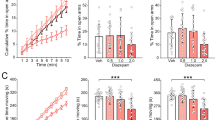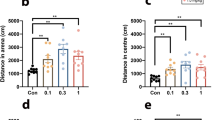Abstract
Research on the effects of antidepressant/antipanic drugs in animal models of anxiety has yielded equivocal results, even after chronic drug regimens. In contrast, we found that the antidepressant/antipanic drug phenelzine, given acutely, produced a clear anxiolytic effect in the elevated plus-maze, a widely-used animal model of “anxiety” that is primarily sensitive to benzodiazepine-type anxiolytics (e.g., diazepam). Furthernore, the effective dose of phenelzine (15 mg/kg) administered to rats was associated with more than a 2-fold increase in whole brain levels of γ-aminobutyric acid (GABA), whereas an ineffective dose of phenelzine (5.1 mg/kg) did not significantly change GABA levels. TheN-acetylated metabolite of phenelzine,N 2-acetylphenelzine, produced neither an anxiolytic effect in the elevated plus-maze nor a significant change in whole-brain levels of GABA. However, both phenelzine andN 2-acetylphenelzine potently inhibited monoamine oxidase inhibitors such as phenelzine in the treatment of depression in humans. These results suggest that the mechanism whereby phenelzine produces anxiolytic effects in the plus-maze model is unique to a facilitatory action on brain levels of GABA, in contrast to classical benzodiazepines, which produce anxiolytic effects by enhancing the affinity of the GABAA-receptor for GABA.
Similar content being viewed by others
References
Baker GB, Wong JT, Yeung JM, Coutts RT (1991) Effects of the antidepressant phenelzine on brain levels of γ-aminobutyric acid (GABA). J Affect Dis 21:207–211.
Beardslee SL, Papadakis E, Fontana DJ, Commissaris RL (1990) Antipanic drug treatments: failure to exhibit anxiolytic-like effects on defensive burying behavior. Pharmacol Biochem Behav 35:451–455
Briley M, Chopin P, Veigner M (1986) The plus-maze test of anxiety: validation in different rat strains and effect of a wide range of antidepressants. Br J Pharmacol 87:217P
Cassella JV, Davis M (1985) Fear-enhanced acoustic startle is not attenuated by acute or chronic imipramine treatment in rats. Psychopharmacology 87:278–282
Cole JC, Rodgers RJ (1995) Ethological comparisons of the effects of diazepam and acute/chronic imipramine, on the behaviour of mice in the elevated plus-maze. Pharmacol Biochem Behav 52:473–478
Commissaris RL, Humrich J, Johns J, Geere DG, Fontana J (1995) The effects of selective and non-elective monoamine oxidase (MAO) inhibitors on conflict behavior in the rat. Behav Pharmacology 6:195–202.
Corbett R, Fielding S, Cornfeldt M, Dunn RW (1991) GABAmimetic agents display anxiolytic-like effects in the social interaction and elevated plus maze procedures. Psychopharmacology 104:312–316
Costall B, Jones BJ, Kelley ME, Naylor RJ, Tomkins DM (1989) Exploration of mice in a black and white test box: validation as a model of anxiety. Pharmacol Biochem Behav 15:695–699
Coutts RT, Mozayani A, Pasutto FM, Baker GB, Danielson TJ (1990) Synthesis and pharmacological evaluation of acyl derivatives of phenelzine. Res Commun Chem Path Pharmacol 67: 3–15
Crawley JN (1981) Neuropharmacological specificity of a simple animal model for the behavioral actions of benzodiazepines. Pharmacol Biochem Behav 15:695–699
Cuomo V, Cagiano R, De Saliva MA, Maselli MA, Renna G, Racagni G (1988) Ultrasonic vocalization in response to unavoidable aversive stimuli in rats: effects of benzodiazepines. Life Sci 43:485–491.
Danielson TJ, Coutts RT, Baker GB, Rubens M (1984) Studies in vivo and in vitro onN-acetylphenelzine. Proc West Pharmacol Soc 27:507–510
File SE (1987) The contribution of behavioural studies to the neuropharmacology of anxiety. Neuropharmacology 26:877–886
File SE, Johnston AL (1987) Chronic treatment with imipramine does not reverse the effects of three anxiogenic compounds in a test of anxiety in the rat. Neuropsychobiology 17: 187–192.
Fontana DJ, Carbary TJ, Commissaris RL (1989) Effects of acute and chronic anti-panic drug administration on conflict behavior in the rat. Psychopharmacology 98:157–162.
Gao B, Cutler MG (1994) Effects of acute and chronic administration of the antidepressants, imipramine, phenelzine and mianserin, on the social behavior of mice. Neuropharmacology 33:813–824.
Gardner C (1985) Inhibition of ultrasonic distress vocalizations in rat pups by chlordiazepoxide and diazepam. Drug Dev Res 5:185–193
Handley S, McBlane JW (1992) Opposite effects of fluoxetine in two animal models of anxiety. Br J Pharmacol 107:446P
Johnston AL, File SE (1988) The profiles of the anti-panic compounds, triazolobenzodiazepines and phenelzine in two animal tests of anxiety. Psychiatry Res 25:81–90.
Klein DF (1981) Anxiety reconceptualized. In: Klein DF, Rabkin JD (eds) Anxiety: new research and changing concepts. Raven Press, New York, pp 235–262
Lister RG (1990) Ethologically-based animal models of anxiety disorders. Pharmacol Ther 46:321–340.
Lyles GA, Callingham BA (1982) In vitro and in vivo inhibition by benserazide of clorgyline-resistant amine oxidases in rat cardiovascular tissues. Biochem Pharmacol 311417–1424
Mason P, Skinner J, Luttinger D (1987) Two tests in rats for antianxiety effect of clinically anxiety attenuating antidepressants. Psychopharmacology 92:30–34.
McKenna KF, Baker GB, Coutts RT (1991)N 2-Acetylphenelzine: effects on rat brain GABA, alanine and biogenic amines. Naunyn-Schmiedeberg’s Arch Pharmacol 343:478–482
McKenna KF, Baker GB, Coutts RT, Greenshaw AJ (1992) Chronic administration of the antidepressant-antipanic drug phenelzine and itsN-acetylated analogue: effects on monoamine oxidase, biogenic amines, andα 2-adrenoreceptor function. J Pharm Sci 81:832–835.
Nutt DJ, Glue P (1989) Clinical pharmacology of anxiolytics and antidepressants. A psychopharmacological perspective. Pharmacol Ther 44:309–344
Pellow S (1986) Anxiolytic and anxiogenic drug effects in a novel test of anxiety: are exploratory models of anxiety in rodents valid? Methods Find Exp Clin Pharmacol 8:557–565.
Pellow S, File SE (1986) Anxiolytic and anxiogenic drug effects on exploratory activity in an elevated plus-maze: a novel test of anxiety in the rat. Pharmacol Biochem Behav 24:525–529
Pellow S, Chopin P, File SE, Briley M (1985) Validation of open: closed arm entries in the elevated plus-maze as a measure of anxiety in the rat. J Neurosci Methods 14:149–167
Pellow S, Johnston AL, File SE (1987) Selective agonists and antagonists for 5-hydroxytryptamine receptor subtypes, and interactions with yohimbine and FG 7142 using the elevated plus-maze test in the rat. J Pharm Pharmacol 39: 917–928
Pesold C, Treit D (1995) The central and basolateral amygdala differentially mediate the anxiolytic effects of benzodiazepines. Brain Res 671:213–221
Rickels K, Downing R, Schweizer E, Hassman H (1993) Antidepressants for the treatment of generalized anxiety disorder. Arch Gen Psychiatry 50:884–895.
Rodgers RJ, Cole JC (1994) The elevated plus-maze: pharmacology, methodology and ethology. In: Cooper SJ, Hendrie CA (eds) Ethology and psychopharmacology. Wiley, Chichester, pp 8–44
Sayin U, Purali N, Ozkan T, Altug T, Buyukdevrim S (1992) Vigabatrin has an anxiolytic effect in the elevated plus-maze test of anxiety. Pharmacol Biochem Behav 43:529–535
Sheehan DV (1985) Monoamine oxidase inhibitors and alprazolam in the treatment of panic disorder and agoraphobia. Psychiatric Clin N Am 8:49–62
Sheehan DV (1986) Tricyclic antidepressants in the treatment of panic and anxiety disorders. Psychosomatics 27:10–16
Sloley BD, Kah D, Trudeau VL, Delka JG, Peter RE (1992) Amino acid neurotransmitters and dopamine in brain and pituitary of the goldfish: involvement of gonadotropin secretion. J Neurochem 58:2254–2262
Tallman JF, Gallager DW (1985) The GABA-ergic system: a locus of benzodiazepine action. Annu Rev Neurosci 8:21–44
Tanay VA, Baker GB, Greenshaw AJ, Bateson AN (1996) Differential effects of chronic treatment with phenelzine, imipramine or buspirone on GABAA receptor subunit gene expression in rat brain. Br J Pharmacol 117:15p
Treit D (1985) Animal models for the study of anti-anxiety agents: a review. Neurosci Biobehav Rev 9:203–222
Treit D (1994) Animal models of anxiety and anxiolytic drug action. In: den Boer JA, Ad Sitzen JM (eds) Handbook of depression and anxiety: a biological approach. Marcel Dekker, New York, pp 201–224
Treit D, Pinel JPJ, Fibiger HC (1981) Conditioned defensive burying: A new paradigm for the study of anxiolytic agents. Pharmacol Biochem Behav 15:619–626
Zorumski CF, Isenberg KE (1991) Insights into the structure and function of GABA-benzodiazepine receptors: ion channels and psychiatry. Am J Psychiatry 148:162–173
Author information
Authors and Affiliations
Rights and permissions
About this article
Cite this article
Paslawski, T., Treit, D., Baker, G.B. et al. The antidepressant drug phenelzine produces antianxiety effects in the plus-maze and increases in rat brain GABA. Psychopharmacology 127, 19–24 (1996). https://doi.org/10.1007/BF02805970
Received:
Accepted:
Issue Date:
DOI: https://doi.org/10.1007/BF02805970




